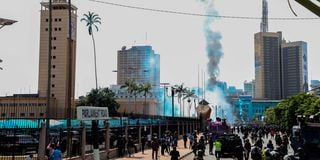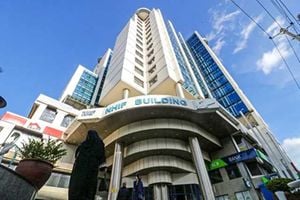Mental health toll of protests feared: Therapist says 'It's not just physical'

The moment a tear gas canister was thrown into one of the classrooms at All Saints Cathedral Kindergarten on Tuesday, June 25, everything came to a standstill at the makeshift emergency unit inside the church compound.
A volunteer paramedic in charge of marshalling the injured demonstrators shifted gears for a moment, asking first for water.
In no time, two paramedics came running with a bucket of water, hoping to neutralise the effects of the tear gas that had now paralysed the centre's services. It did not help.
The darkness continued as protesters fought running battles with police along Kenyatta Avenue. The relentless police fired more canisters, painting the street pink with the rhodamine dye from the water cannons.
On the other side of the emergency entrance, two young men were wheeled in and all attention shifted to them, regardless of the irritable tear-gas-filled air.
The doctors, who were used to handling new casualties, immediately donned gloves and began assessing the patients.
The two patients were unconscious, unable even to give their names.
A woman on a stretcher, her lower limbs severely injured, screamed at the top of her lungs as a team of doctors tried to relieve her pain.
We counted about 15 injured demonstrators, some with minor injuries and others critically injured.
If it had been a normal day, Luqman Ahmed, an injured motorcyclist from Kibra, said he would have earned a few hundred shillings from his daily business as a motorcyclist. At 1pm, he was among those at All Saints Cathedral who had been injured in the protests. He had a bandage over his right eye, swollen lips and a red scarf tied around his neck. His left eye was red. He was in pain.
"As a [bodaboda] rider I can tell you that life has really hit us out here. It was this pain that brought me out of the street today when we heard that the Finance Bill had been passed. This injury is from a rubber bullet. The guy came at close range and shot me," he tells us.
His wounds were dressed and he was sent for psychological care.
Joan Mukami, a psychologist on site, says they receive patients with different types of injuries and send them to different tents depending on the category of their injury.
"We have those who go to the red, green and yellow tents, so you find that they come here with a high level of trauma, others are very anxious and the people they come with are just as shaken and need support," she said.
"Some can't speak. They are really afraid to even let their relatives know that they are here. But the more we can get them through psychological support, the more they can reduce their anxiety," she added.
She explained that the services provided included clinical assessment, medical history, investigations, next of kin and blood grouping.
"We had one patient who came with a bullet wound in his leg and he was not even aware of it. He has since been taken to Mbagathi for further treatment. So far I have seen five patients, three of them with severe trauma," she said.
Boniface Mitambo, the national vice-chairman of the Kenya Union of Clinical Officers (KUCO), who was also at All Saints Cathedral, said one of the reasons they had come out was because they had been on strike for 85 days with 10 demands and the government had not agreed to nine of the 10.
"We decided that since we are out anyway, we should come here and help. More than 50 of us are out today," he said.
At the Jamia Crescent Medical Aid dispensary, ambulances swarmed the narrow lane between Jamia Mall and the medical centre. Some protesters tried to take refuge in the camps as police dispersed the crowds from Kimathi Street.
Dr Ilyas Mohamed, one of the volunteers at Crescent Medical Aid's makeshift emergency centre, tried to restore order and the medics on site were all hands on deck.
"We treat all kinds of injuries, from minor to serious, but we refer the serious ones; this is like a referral centre. We have ambulances from Nairobi County as well as private ambulances. We have trained doctors and clinical officers who look for injured people on the streets and can provide first aid from there," he tells the Nation.Africa.
"The situation here is dire. We are not well. The team that provided us with ambulances has now withdrawn because one of their medics was reportedly shot dead. We are on our own here and we have to carry the injured on motorbikes, some of them in very bad condition," said Dr Amakove Wala, one of the medics at the scene.
"At the moment there is a body here that needs to be taken to the mortuary, but we don't have the means, so we have asked the police to come and collect it. He was brought in dead," she added.
By 7pm on Tuesday, at least 400 people had been treated in the makeshift medical centres.
Earlier, we spoke to some of the volunteers at the centres, including junior doctors who have yet to be deployed by the Ministry of Health. Dr Phelly Chelsea is one of them.
"I am one of the unassigned junior doctors from the class of 2023. We decided to use our skills to help people who were injured during the protests," she says.
Shalini Bhalla-Lucas, a therapist who was also on standby at All Saints Cathedral to receive casualties, told the Nation.Africa that Tuesday was a scary day for many people and that there would be mental health repercussions for a long time.
"People saw their colleagues being tear-gassed and are in shock. This is not just physical. I saw people who couldn't breathe, panicking and some with gaping wounds. Also, the people who are helping are also suffering and I have had to help a number of them," she says.






